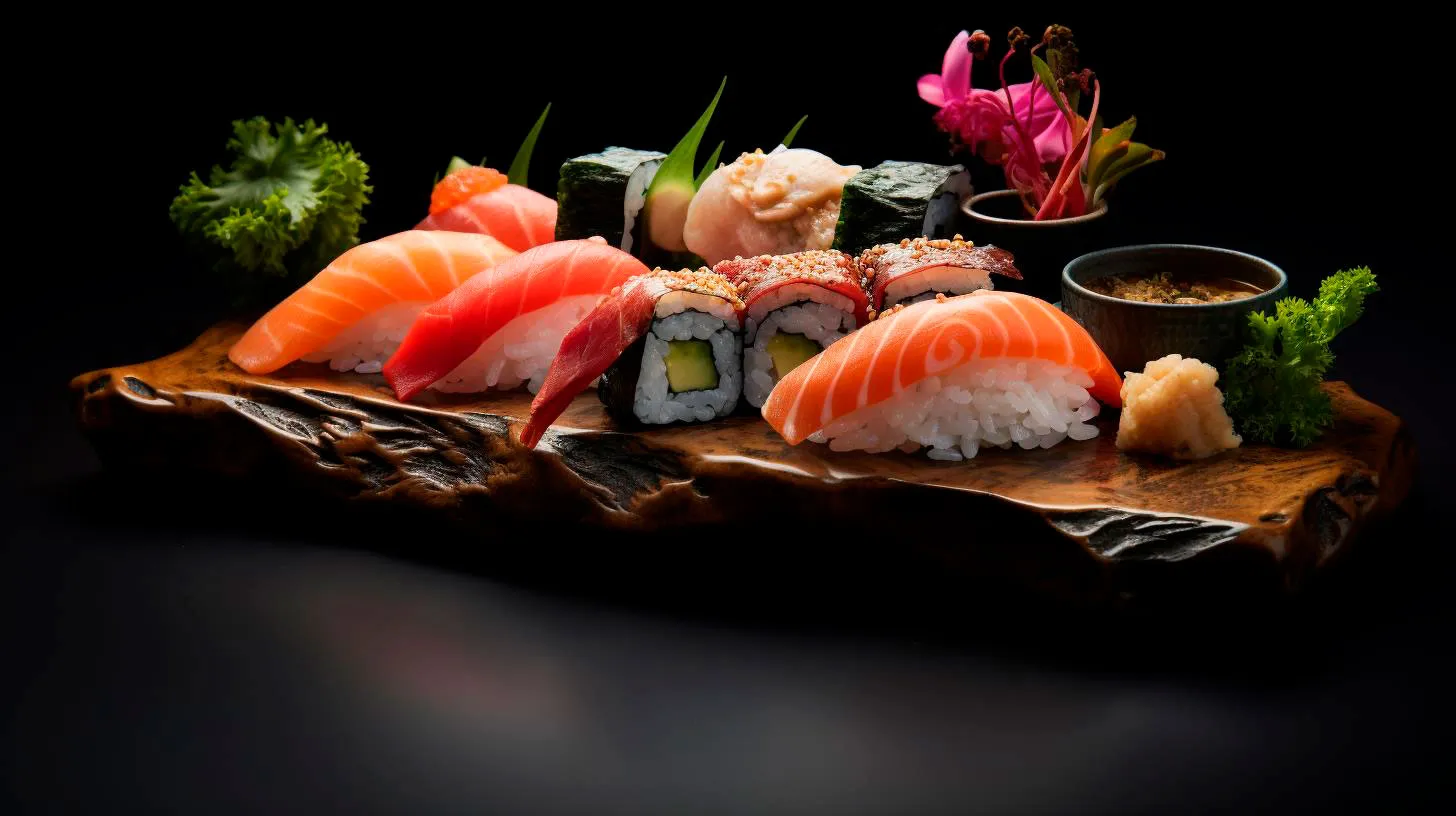Creating Harmony: Pairing Sushi Rice with the Freshest Seafood
Sushi rice, also known as shari, is the foundation upon which all sushi rolls are built. It provides a subtle yet essential flavor that enhances the overall experience of each bite.
The Art of Making Sushi Rice
Preparing the perfect sushi rice requires finesse and attention to detail. It starts with the selection of the right type of rice – short-grain Japanese rice. This variety has a higher starch content, giving it the desired stickiness and texture required for sushi.
The rice is then washed and soaked to remove excess starch, resulting in a cleaner taste. Once drained, the rice is cooked with the ideal balance of water, creating a slightly sticky yet firm texture. While cooking, it’s essential to resist the temptation to lift the lid and allow the steam to work its magic.
After the rice is cooked, it needs to be seasoned with a mixture of rice vinegar, salt, and sugar. This combination adds a refreshing tanginess to the rice, balancing out the richness of the seafood. Carefully folding the seasoned mixture into the rice ensures that each grain is evenly coated.
Key Takeaway: The art of making sushi rice involves using the right type of rice, washing and soaking it, cooking it with precision, and seasoning it with a vinegar mixture for a perfect balance of flavors.
Sushi Rice and Seafood Pairings
Pairing sushi rice with the freshest seafood is an art form in itself. The texture, taste, and mouth-watering aroma of the seafood must harmonize with the flavors of the rice to create a truly exceptional sushi experience. Here are some classic sushi rice and seafood pairings:
- Maguro (Tuna): The buttery texture and mild flavor of maguro tuna pair excellently with sushi rice. The contrast in textures creates a delightful sensation with every bite.
- Hamachi (Yellowtail): Rich in flavor, hamachi is often enjoyed with sushi rice. The slightly firm and fatty nature of the fish enhances the overall taste and offers a pleasant mouthfeel.
- Unagi (Grilled Eel): The sweet and savory taste of grilled eel is perfectly balanced by the tangy sushi rice. This combination delivers a burst of flavors that leave a lasting impression.
- Ebi (Shrimp): The delicate sweetness of shrimp makes it a popular choice for sushi. When combined with sushi rice, the flavors blend harmoniously, creating a satisfying and refreshing palate.
These are just a few examples of the numerous combinations possible when pairing sushi rice with seafood. The art of sushi lies in experimenting with different flavors and textures to create symphonies of taste on a plate.
Key Takeaway: Pairing sushi rice with various seafood options such as maguro, hamachi, unagi, and ebi creates a diverse range of flavors that complement each other, resulting in a multi-faceted sushi experience.
The Advantages of Sushi Rice
The use of sushi rice in sushi-making offers several advantages that contribute to its popularity:
- Stickiness: The stickiness of sushi rice allows it to hold its shape when rolled, ensuring that the toppings and fillings remain intact while eating.
- Texture: The slightly chewy texture of sushi rice adds an interesting element to the overall mouthfeel of each sushi roll, enhancing the dining experience.
- Flavor Absorption: Sushi rice readily absorbs the flavors of the seafood and other ingredients, amplifying the taste profile of each bite.
- Contrasting Taste: The mildly sweet and tangy flavor of sushi rice acts as a contrast to the rich and savory flavors of the seafood, creating a harmonious balance.
Key Takeaway: Sushi rice’s advantages lie in its stickiness, texture, ability to absorb flavors, and its ability to create a contrasting taste that enhances the overall sushi dining experience.
In conclusion, sushi is an art that combines the freshest seafood with perfectly crafted sushi rice. The meticulous process of making sushi rice elevates it from being a mere accompaniment to becoming an essential element that enhances the overall flavors and textures of sushi. Experimenting with different seafood pairings and enjoying the advantages of sushi rice allows sushi lovers to embark on a culinary adventure like no other. So, the next time you indulge in a plate of sushi, take a moment to appreciate the harmony created by the pairing of sushi rice with the freshest seafood.
Unlocking the Secrets: Mastering the Perfect Sushi Rice
In this article, we will delve deep into the art of making the perfect sushi rice, unlocking its secrets and providing you with valuable tips to elevate your sushi game.
The Importance of Sushi Rice
Japanese sushi chefs often say that sushi rice is the heart and soul of sushi. It binds all the other ingredients together and creates a harmonious union of flavors and textures. The perfect sushi rice should be slightly sticky but not mushy, with each grain glistening and separate.
Some key reasons why sushi rice is so important:
- Texture: Sushi rice should have just the right amount of stickiness to hold the toppings and fillings in place while still allowing the sushi to fall apart effortlessly in your mouth.
- Flavor: The rice should have a delicate yet distinctive flavor that complements the fish and other ingredients used in sushi.
- Aesthetic Appeal: Well-prepared sushi rice has an appealing glossy appearance that adds to the overall visual appeal of the sushi roll.
The Secrets to Perfect Sushi Rice
Now, let’s unlock the secrets to mastering the art of making perfect sushi rice:
1. Choosing the Right Rice
When selecting rice for sushi, it’s essential to choose a short-grain variety such as Japanese sushi rice or Calrose rice. These varieties have a higher starch content, resulting in a stickier texture that is crucial for sushi.
2. Proper Washing and Soaking
Rinse the rice thoroughly under cold water until the water runs clear. This step removes excess starches and impurities. After rinsing, allow the rice to soak in water for about 30 minutes before cooking. Soaking helps the rice absorb moisture evenly, resulting in a better texture.
3. Precise Measurements and Ratios
For perfectly cooked sushi rice, use a ratio of 1:1 for rice and water. This means if you are cooking 1 cup of rice, add 1 cup of water. Consistency in measuring the rice and water quantities is crucial for achieving the desired texture.
4. Cooking Techniques and Timing
Use a heavy-bottomed pot with a tight-fitting lid to cook the rice. Bring the rice and water to a boil over medium-high heat, then reduce the heat to low and simmer, covered, for about 15 minutes. After cooking, let the rice sit, covered, for another 10 minutes to allow the grains to steam and fluff up.
5. The Art of Seasoning
Sushi rice is not only about texture but also flavor. Once the rice is cooked, transfer it to a non-metallic bowl and gently fluff it with a wooden spatula. While the rice is still warm, season it with sushi vinegar, a blend of rice vinegar, sugar, and salt. Use approximately 80-100ml of sushi vinegar for every 300 grams of cooked rice. Gently fold the vinegar into the rice using a cutting motion, ensuring each grain is evenly coated.
Key Takeaways
- Sushi rice is the foundation of exceptional sushi, providing texture, flavor, and aesthetic appeal.
- Choosing the right variety of short-grain rice is vital for achieving the perfect sushi rice.
- Properly washing and soaking the rice before cooking helps to remove excess starch and improve texture.
- Using precise measurements and ratios of rice and water ensures consistency in the final result.
- Mastering cooking techniques and timing is crucial for perfectly cooked sushi rice.
- The art of seasoning with sushi vinegar adds the final touch of flavor to the rice, making it irresistibly delicious.
Unlocking the secrets of mastering the perfect sushi rice takes practice and attention to detail. By following these tips and techniques, you’ll be well on your way to creating sushi that is not only visually stunning but also bursting with flavor. Elevate your sushi experience by mastering the art of sushi rice – your taste buds will thank you!
From Sticky to Fluffy: Achieving the Ideal Texture in Sushi Rice
In this article, we will explore tips and techniques to transform sticky rice into fluffy clouds of perfection that will elevate your sushi to the next level.
The Importance of Texture in Sushi Rice
Texture plays a significant role in the overall sushi experience. The right texture not only enhances the taste, but it also affects the structural integrity and visual appeal of each sushi roll. Here’s why the texture of sushi rice matters:
- Taste Sensation: Properly textured sushi rice allows the flavors of the fish, vegetables, and other ingredients to meld harmoniously.
- Balance: Achieving the ideal texture ensures that the rice doesn’t overpower the delicate flavors of the sushi fillings but rather complements and enhances them.
- Roll Cohesion: The right texture helps sushi rolls hold their shape, preventing them from unravelling during handling and consumption.
Secrets to Fluffy Sushi Rice
Let’s uncover some expert secrets to transforming your sticky rice into a fluffy, tender delight:
1. Proper Washing and Rinsing
Start by washing the rice several times until the water runs clear. This helps remove any excess starch that can make the rice sticky. Use your fingers to gently stir the rice while rinsing it under cold water. Remember, the goal is to make the rice fluffy, not to break the delicate grains.
2. Precise Water-to-Rice Ratio
The right water-to-rice ratio is essential for achieving the perfect texture. A general rule of thumb is to use one and a half cups of water for each cup of rice. Remember, different varieties of rice may require slight adjustments in the ratio, so be mindful of the specific rice type you are using.
3. The Magic of Soaking
Soaking the rice before cooking is the secret to achieving an even texture and ensuring proper moisture absorption. Let the rinsed rice soak in water for at least 30 minutes before cooking. This process helps the grains cook more uniformly and results in fluffy rice perfection.
4. The Right Cooking Technique
Invest in a good quality rice cooker that offers precise temperature control. This will help you cook the rice to perfection. It’s essential to follow the instructions provided with your cooker and set the appropriate cooking time and temperature. Avoid peeking or stirring the rice while it’s cooking, as this can disrupt its texture.
5. Fluffing and Cooling
Once the rice is cooked, let it sit in the rice cooker or pot for a few minutes, allowing it to steam and moisten further. Once the cooking process is complete, use a wooden spatula or rice paddle to gently fluff the rice. This process helps release excess moisture and gives the rice a light and airy texture. Cooling the rice to room temperature is crucial before using it for sushi preparation.
Key Takeaways
Now that you are armed with valuable tips to achieve the ideal texture in sushi rice, let’s summarize the key takeaways:
- Optimal Texture: The ideal sushi rice texture provides a balance of taste, enhances the sushi fillings, and ensures roll cohesion.
- Preparation: Properly wash and rinse the rice, use precise water-to-rice ratios, and soak before cooking for even texture.
- Cooking Technique: Invest in a quality rice cooker, avoid disturbing the rice while cooking, and fluff the rice gently after cooking.
Remember, achieving the perfect texture in sushi rice is an art form that requires practice and attention to detail. With these tips in your sushi-making arsenal, you can now embark on a journey to create sushi with rice that is irresistibly fluffy, delicate, and delicious!
The Art of Balance: Balancing Sweetness and Acidity in Sushi Rice
Achieving this balance requires precision and skill, as it sets the stage for the entire sushi experience.
Let’s delve into the art of balance and explore the significance of sweetness and acidity in sushi rice.
The Sweetness Factor
One of the key components to a great sushi rice is a touch of sweetness. Traditionally, sushi rice is seasoned with rice vinegar, sugar, and salt. The sugar serves a crucial role in enhancing the overall taste by adding a hint of sweetness. This sweetness not only complements the flavors of the ingredients used in sushi but also helps balance out the natural saltiness of soy sauce used for dipping.
Key Takeaway:
- A touch of sweetness in sushi rice enhances the overall flavor profile.
- It complements the ingredients used in sushi and balances out the saltiness of soy sauce.
The Role of Acidity
Acidity is another crucial element in achieving the perfect balance in sushi rice. Rice vinegar, which has a mild acidic taste, is utilized to impart the desired tanginess. The acidity helps cut through the richness of fatty fish and adds a refreshing note to the sushi. Furthermore, the slight tanginess of the rice vinegar works in harmony with the sweetness, creating a well-rounded and delightful taste.
Key Takeaway:
- Acidity adds a tangy and refreshing note to the sushi rice.
- It cuts through the richness of fatty fish, creating a balanced taste.
The Challenge of Balance
Striking the perfect balance between sweetness and acidity in sushi rice is a challenging task that sushi chefs master over years of practice. Fine-tuning the ratio of rice vinegar, sugar, and salt requires careful consideration and attention to detail. The goal is to create a rice that has a subtle but noticeable sweetness with a delicate tang that doesn’t overpower the other flavors present in sushi.
Key Takeaway:
- Achieving the perfect balance in sushi rice requires practice and precision.
- Mastering the ratio of rice vinegar, sugar, and salt is crucial.
- Sushi rice should have a delicate tang that doesn’t overpower other flavors.
The Sushi Rice Revelation
Understanding the art of balance in sushi rice opens up a world of possibilities for creating delightful sushi experiences. The delicate balance between sweetness and acidity elevates the flavors and harmonizes the overall taste. Whether you’re enjoying a classic nigiri sushi or indulging in a creative sushi roll, the meticulously prepared rice is what sets exceptional sushi apart from the rest.
So, next time you savor a piece of sushi, take a moment to appreciate the artistry that goes into balancing sweetness and acidity in the rice. It’s truly a testament to the skill and dedication of the sushi chef.


